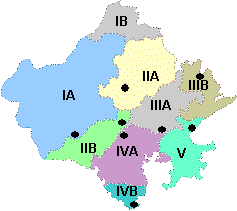Rajasthan Cropping Pattern
Cropping pattern means the proportion of area under various crops at a point of time. The crop statistics published by the governments are used to denote the cropping patterns. Cropping pattern is, however, a dynamic concept as it changes over space and time.The cropping patterns of a region are closely influenced by the geo-climatic, socio-cultural, economic, historical and political factors. The physical environment (physiographic, climate, soils and water) imposes limits on the growth and distribution of plants and animals.
Depending on the terrain, topography, slope, temperature, amount and reliability of rainfall, soils and availability of water for irrigation, the cropping patterns varyfrom region to region.
Agro Climatic Zones of Rajasthan
| Zone | Area | Total
Area (million ha) | District Covered | Average Rainfall (mm) | Temp OC | Major Crops | Soils | Agriculture Research Station | ||
| Max. | Min | Kharif | Rabi | |||||||
| IA | Arid western plain | 4.74 | Barmer & part of Jodhpur | 200-370 | 40.0 | 8.0 | Pearlmillet Mothbean Sesame | Wheat, Mustard, Cumin | Desert soils and sand dunes aeolian soil, coarse sand in texture some places calcareous | Mandore, Jodhpur |
| IB | Irrigated north western plain | 2.10 | Sriganganagar, Hanumangarh | 100-350 | 42.0 | 4.7 | Cotton, Clusterbean | Wheat, Mustard, Gram | Alluvial deposites calcareous, high soluble salts & exchangeable sodium | Ganganagar |
| IC | Hyper arid partial irrigated zone | 7.70 | Bikaner, Jaisalmer, Churu | 100-350 | 48.0 | 3.0 | Pearlmillet Mothbean Clusterbean | Wheat, Mustard, Gram | Desert soils and sand dunes aeolian soil, loamycoarse in texture & calcareous | Beechwal Bikaner |
| IIA | Internal drainage dry zone | 3.69 | Nagaur, Sikar, Jhunjhunu, Part of Churu | 300-500 | 39.7 | Subscribe on YouTube width="6%">5.3 | Pearlmillet Clusterbean Pulses | Mustard, Gram | Sandy loam, sallow depth red soils in depressions | Fatehpur, Sikar |
| IIB | Transitional plain of Luni basin | 3.00 | Jalore, Pali, Part of Sirohi, Jodhpur | 300-500 | 38.0 | 4.9 | Pearlmillet Clusterbean sesame | Wheat, Mustard | Red desert soils in Jodhopur, Jalore & Pali sierzems in Pali & Sirohi | Keshwana, Jalore |
| IIIA | Semi arid eastern plains | 2.96 | Jaipur, Ajmer, Dausa, Tonk | 500-700 | 40.6 | 8.3 | Pearlmillet Clusterbean Sorghum | Wheat, Mustard, Gram | Sierozens, eastern part alluvial, west north west lithosols, foot hills, brown soils | Durgapura, Jaipur |
| IIIB | Flood prone eastern plain | 2.77 | Alwar, Dholpur, Bharatpur, Karoli, S.Madhopur | 500-700 | 40.0 | 8.2 | Pearlmillet Clusterbean Groundnut | Wheat, Barley, Mustard, Gram | Alluvial prone to water logging, nature of recently alluvial calcareous has been observed | Navgaun, Alwar |
| IVA | Sub-humid southern plains | 3.36 | Bhilwara, Sirohi, Udaipur, Chittorgarh | 500-900 | 38.6 | 8.1 | Maize, Pulses, Sorghum | Wheat, Gram | Soil are lithosolsat foot hills & alluvials in plains | Udaipur |
| IVB | Humid sothern plains | 1.72 | Dungarpur, Udaipur, Banswara, Chittorgarh | 500-1100 | 39.0 | 7.2 | Maize, Paddy Sorghum Blackgram | Wheat, Gram | Predominantly reddish medium texture, well drained calcareous, shallow on hills, deep soils in valleys | |
| V | Humid south eastern plain | 2.70 | Kota, Jhalawar, Bundi, Baran | 650-1000 | 42.6 | 10.6 | Sorghum Soyabean | Wheat, Mustard | Black of alluvial origin, clay loam, groundwater salinity | Ummedganj, Kota |
Land-Use pattern in Rajasthan state
S.N Land Use Details Area (in lakh hactare)
1 Total Geographical area 342.66
2 Forest 26.60
3 Non agriculture use 17.60
4 Barren & unculturable land 24.98
5 Area unfit for cultivation (3+4) 42.59
6 Cultivable wasteland 45.46
7 Pasture 17.08
8 Land under misc trees crops& groves 0.14
9 Uncultivated land excluding fallows (6+7+8) 62.69
10 Fallow 36.82
11 Net Area sown 173.94
12 Gross area sown 216.64
13 Net area Irrigated 52.39
14 Gross Area irrigated 63.93
15 Cultivable land(6+10+11) 256.22
16 Rainfed cultivable land (6+10+11-13) 203.83
- Culturable Wasteland is highest in Ajmer, Alwar and Jaisalmer and minimum at Hanumangarh, Jhunjhunu and Bharatpur. Fallow lands other than current fallow cover the highest area in Alwar, Ajmer and Jodhpur whereas they are lowest at Karauli, Dholpur and Bharatpur. The current fallow land covers the highest area in Ajmer, Alwar and Barmer whereas the lowest are at Karauli, Banswara and Rajsamand.
- Under the category of Net Area Sown and Net Area Sown more than once Ajmer and Alwar stand on the top two positions with Barmer and Hanumangarh at the third positions respectively. Dhoplur, Dungarpur and Rajsamand are the lowest three in the category of Net Area Sown and Dungarpur, Sirohi and Rajsamand are the last three of Net Area Sown more than once.
- It can be seen that the western districts of Jaisalmer, Bikaner and Barmer have large stretches of sandy soils therefore a very high percentage of cultivable waste and fallow land is present in the region. The net sown area is also less than the other types of land uses here. Higher percentage of seasonal pasture lands exist in Barmer, Jodhpur, Jalore and Nagaur districts. Generally, Forest areas are evidently absent in the entire western Rajasthan Churu, Nagaur, Jodhpur, Pali and Jalore districts lying in the mid western districts of arid and the semi arid zone support only rain-fed crops in this area and because of low rainfall the percentage of fallow land is quite high. The net sown area is the highest in the semi-arid zone and the sub-humid parts of eastern Rajasthan which also accounts for extensive agriculture. Due to the presence of hilly terrain in parts of Bhilwara, Chittorgarh, Udaipur, Kota and Baran districts the percentage of cultivable waste and the land put to non agricultural use is highest.


